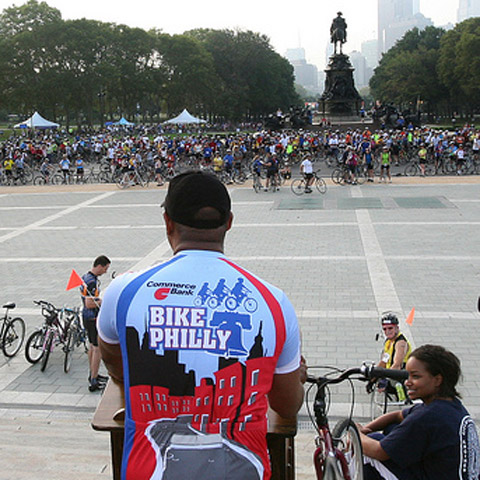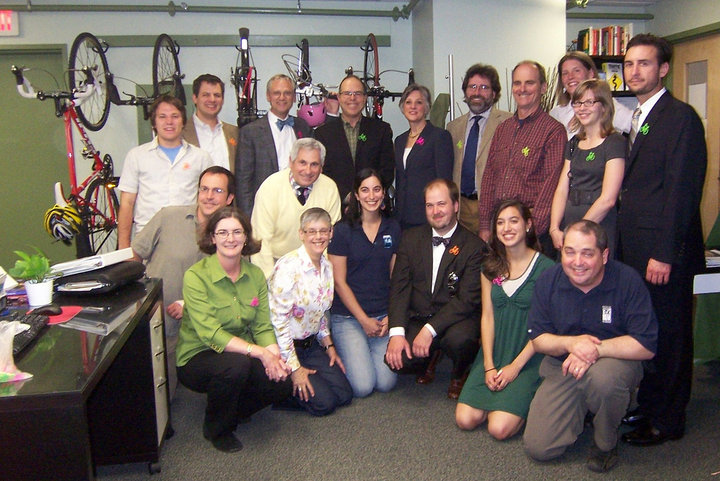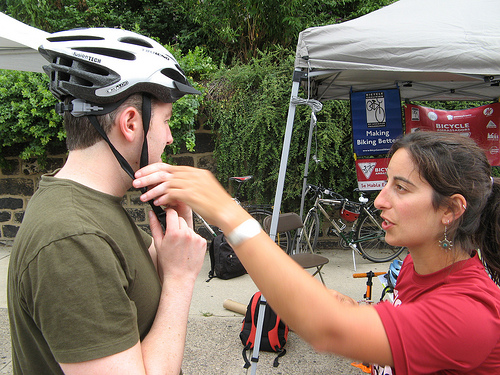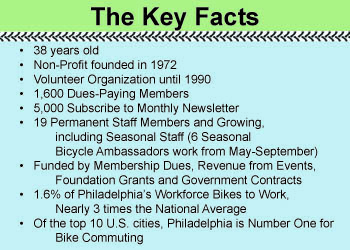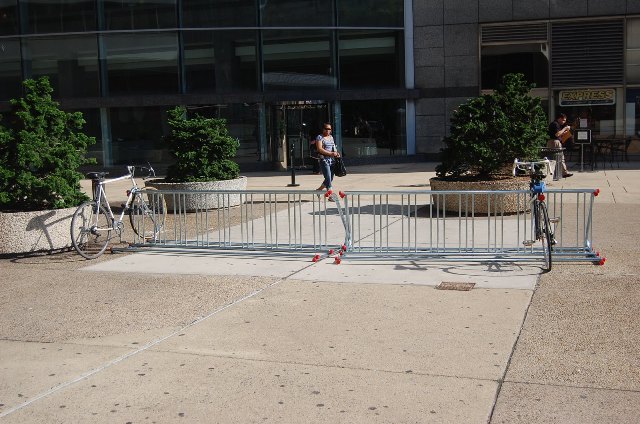Keeping Philly’s wheels turning
By Billy Gallagher
For PlanPhilly
If you’ve picked up the Daily News lately, you may have noticed that columnist Stu Bykofsky has written a series of less than complimentary opinion pieces about the increased bike traffic on the new bike lanes in the city and the Bicycle Coalition of Greater Philadelphia’s role in that commuting makeover. Bykofsky opined on the subject as recently as May 24 with a heavy criticism of the way the Coalition counts the number of bicycles using the new lanes on Spruce and Pine Streets.
Sarah Clark Stuart, Campaign Director of the Bicycle Coalition, a non-profit with the goal of making bicycling here better through advocacy and education, says Bykofsky is missing a bigger, more accurate picture. “Every time he has asked for information or had questions, we have answered them. We’ve shared our data with him. We’ve offered to have him come look at our data and invited him to come count bikes with us,” she said. ”He’s refused every invitation and despite us sharing our data and information with him, all he has tried to do with it is try to discredit it and discredit us.”
The scribe’s criticism may work in the Coalition’s favor. John Boyle, the group’s Advocacy Director, believes the columns have given the organization good exposure. Boyle went on to respond to Bykofsky, “the reason why we count bicycles is we are filling a void. The other agencies that are responsible for transportation don’t count bicycles. There should be some system that counts bicycles the way SEPTA counts riders or PennDOT counts vehicles crossing a bridge. We are a small nonprofit doing a job that really should be done by one of the bigger agencies.”
“They have willingly shared information, some of which, as I’ve reported in my columns, is flawed,” Bykofsky said Friday. “I have tried to discredit the bad information, not the Coalition. Me counting bikes at some location, one time, would prove nothing. A major theme of what I’ve written deals with illegal behavior (such as bicycle sidewalk-riding) by far too many bicyclists, which the Coalition cannot deny. Yes, some non-partisan agency should do it. I have written that it is bad policy for the city to rely on statistics provided by an advocacy group. That is a poor practice and any sensible person knows it.”
Truth be told, the city did not rely on statistics provided by an advocacy group. Philadelphia transportation officials created the Spruce and Pine Street bike lanes based on a traffic study conducted by Pennoni Associates.
Stuart said part of the reason why some agencies have resisted accommodating bicyclists is they don’t believe there are cyclists using the facilities [bike lanes, bike paths, etc.] at all.
“That’s why the coalition started counting them to show that there are this many bicyclists going by this point at this time,” she said. “The coalition has been using the same method for 20 years and it has created a database and that database is important because it shows trends. It has shown a trend that bicycling is going up. We have a Fall Count every year which we use to measure the trends. In addition, we periodically supplement those counts on special occasions (the most recent SEPTA strike) and when the Bicycle Ambassadors started working last year at other locations and times. For example, we have counted at the Ben Franklin Bridge all day last summer and we did a Spring Count this year.

2010 Bicycle Ambassadors Team: (L to R) Top- Hannah, Erica, Celia, Jonathan; Bottom- Julian, Brian
“It is important in our advocacy to show decision makers that bicyclists are using these streets and bridges and in significant numbers and there is good reason to invest in improving the infrastructure,” she said. “It’s pretty simple and the conclusions we have drawn from that data are completely valid.”
Stuart noted that the conclusions they have drawn from the counts are that bicycle traffic (the average number of bicycles moving through a location per hour) have been increasing since the Coalition’s original counts in 1990. She said that between 2005 and 2008, bicycle traffic across the Schuylkill River Bridges doubled. The increase in the number of bicyclists that the Coalition documented was verified and supported by the U.S. Census Bureau, which documented the same jump over the same time period. http://blog.bicyclecoalition.org/2009/10/philadelphia-is-no-1-among-big-cities.html
“The other conclusion that we have drawn is that the Spruce/Pine enhanced bike lanes have drawn more bicyclists to those streets and that sidewalk riding on those streets have gone down,” she said. “We conclude from our counts that better infrastructure does attract more bicyclists.”
The wide-ranging story that follows is about much more than a chronicle about a dust-up between the Bicycle Coalition and a Daily News columnist. But that argument is a testament to the Coalition’s tough role in making Philadelphia a more commuter friendly city – and that job is one that is crucial and under-publicized and complex. PlanPhilly recently sat down with Coalition staffers to get their take on a number of issues like safety and cycling best practices that impact pedestrians, cyclists and automobile drivers here. We also asked for updates on Coalition initiatives, especially the new hot button issue: bike lanes. What follows is a blend of narrative, Q&A and a list of Coalition resources.
Bike Lanes: A Little History
When Ed Rendell was running for mayor of Philadelphia the Bicycle Coalition started a campaign to improve cycling here after Philadelphia was named the worst city for bicycling in the country in 1987. Rendell kept his election promise to create a bicycle task force in the early and mid 1990s that included members of the Bicycle Coalition. The group made suggestions for and sought funds to develop potential improvements for a bicycle network.
Consultants came in and drew up the plans that included placing bike lanes on streets that could accommodate them and a deal was struck to leave parking spaces on streets intact. Some of the major roads in North Philadelphia and Northeast Philly got a redo with the addition of bike lanes and center turn lanes and the loss of vehicular lanes. About a half dozen major streets saw those car lane reductions, including Grant Ave., Ogontz Ave., Allegheny Ave., and Morrell Ave.
About 210 miles of bike lanes were developed from that original plan, which was put in place from 1995 to 2006. One of the most recent bike lanes was created on 22nd St., going north from Washington Ave. to the Benjamin Franklin Parkway. Planners were able to accomodate it while keeping the two vehicular lanes and parking on either side because it was a wide street. Almost every other north-south street is narrow, so 22nd it is one of the heaviest used bike lanes in the city. Since 2006, no new major bike lanes were added until Spruce and Pine were put in place last year.
Of the more than 200 miles of bike lanes put in, only 4 miles existed in Center City. According to the 2000 Census, 80 percent of bike commuters live within four miles of City Hall. The Spruce and Pine Street bike lanes doubled Center City’s total and are the first here to replace car lanes.
Spruce and Pine are residential streets with posted speed limits of 25 miles per hour that are often exceeded. So traffic calming was one factor that went into the creation n of bile lanes there. Spruce and Pine were also picked because after looking at traffic volumes of all east-west streets, it was determined that these automobile lanes could easily be taken out and little difference would be felt in overall volume and flow of traffic in the grid. “That’s the case in a lot of places – there is much more space allocated to motor vehicles than they need.” Stuart said.
Why do we need more bike lanes?
Sarah Clark Stuart: “You need to put in bike lanes to plan for the future. If the city is going to be a sustainable city that provides or accommodates many different kinds of transportation, it needs to put in infrastructure for bicyclists to help grow the number of people who bike for work or school or errands. And so it’s not about who’s using it now, it’s about who’s using the street in 20 years.
“And, streets get repaved once every ten to twenty years. So, your opportunity to go in and repaint the space on a street is once a generation. So you need to do it when the street is resurfaced. Therefore, that’s when you should be going in and allocating the space to encourage the kinds of transportation modes you want to see for the next ten to twenty years.
“Right now, most of our streets reflect a mentality that existed in the 1950s. If we’re going to be a city that’s ready to be adaptable to an economy that reduces greenhouse gases and deals with climate change then we have to have roads that encourage people to walk and bike and use their cars less for short trips.
“The obesity rate in Philadelphia is around 30 percent. Twenty five percent of trips made by Americans are less than one mile; forty percent are less than four miles. When you think about that, that means that people are getting in their cars and driving one to four miles and could easily bike there faster, and have no impact on air pollution and climate. But they’re not going to do that if they’re afraid and they don’t feel like they belong in the street. And when most people look at the street, they don’t feel welcome to come on their bike. That’s why putting in bike lanes is so important. That’s why making bike lanes feel safer by separating them from the street or giving them more room is so important. That was the purpose of the Spruce and Pine bike lanes.”
What kind of bike lanes should we have?

SCS: “Some cars park in bike lanes, which is a problem. But they generally stay away from (driving in) bike lanes. It’s my personal opinion that lanes help drivers feel like they know where they belong and bicyclists know where they belong. You’ve got folks who don’t think painted bike lanes are enough; they want physically separated bike lanes, which is what Europe has. And you’ve got folks who think bike lanes are hugely a waste of space and should be eliminated.”
John Boyle: “There’s a broad spectrum of opinion unlike other modes of transportation. There are different levels of comfort and skill. Somebody taking their children out for a ride wants more separation. There’s a wide variety of facilities that accommodate different levels of skill. The goal is accomplishing what ever makes it comfortable for someone to get out there and ride.”
Enough with the bike lanes! What else can we do?
SCS: “More bike parking is definitely a need. Bike boxes would greatly help intersection management, as they allow bikes to come to the front of the line of cars, giving bikes a few seconds to get out ahead of cars and get out of the way. Letting pedestrians go a few seconds early before cars start turning right over the pedestrian walk would allow traffic and bikes to flow better. The city has all these conflicts between cars, bikers, and pedestrians that could be fixed with a few simple things.
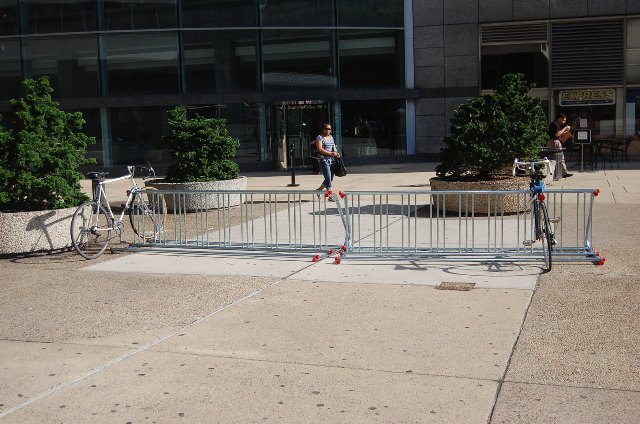
“Additionally, we need better connections between roads and trails, such as at the Ben Franklin Bridge. Education wise, the city and state have an enormous job on their hands in educating bicyclists, pedestrians, and drivers about road safety.”
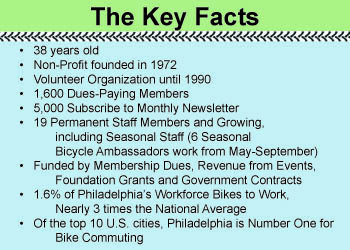
What is the biggest safety issue in the city?
SCS: “It’s a combination of an enforcement, education, and engineering problem. Bicyclists need to learn the rules of the road and obey all traffic laws, as do drivers and pedestrians. And most importantly, they need to treat each other in a civilized manner.
What about sidewalk riding?

SCS: “It’s illegal and a very bad idea and people shouldn’t do it. And it’s dangerous. That’s a huge misperception people have, that they are safer on the sidewalks. They are not and it’s a huge risk for pedestrians. Once you get on a bicycle, you are on a vehicle. And vehicles belong in the street. People think they can be a pedestrian with wheels.”
How does the Bicycle Coalition compare to initiatives in other U.S. Cities?
JB: “Three years ago we’d be smaller per capita, but we’ve been around a long time and we’re not really well known but we are known enough. Now, I think we are coming up on par with the big organizations: San Francisco, New York, Portland, Chicago. Those are probably the organizations that are larger than us but we are kind of entering into their level in terms of budget and manpower. Once you get below us, a lot of these organizations are one, two, three employees. We are entering the next level at this point.”
What challenges does the Coalition face in the future?
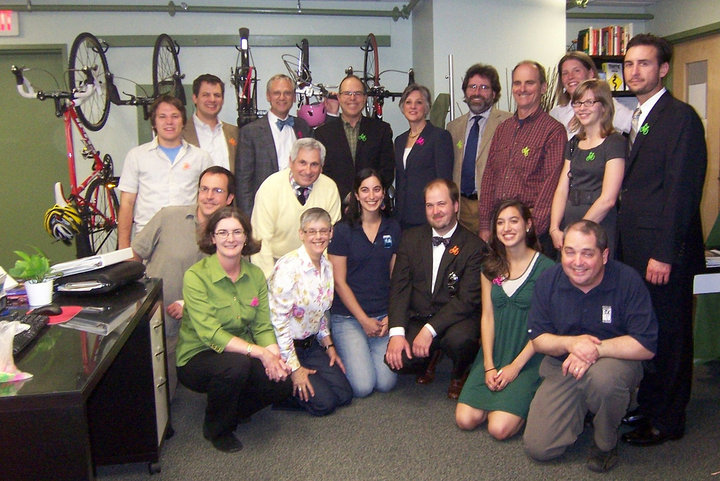
The Coalition staff
SCS: “One [challenge] is managing our growth. Because of two government contracts, we have the opportunity to hire new employees and have hired a lot of our people. That presents a lot of challenges in terms of managing a much larger organization than we were managing even a year and a half ago. I think growing our membership base is something we want to do and need to do … I think we want to increase even more. Because ultimately that’s the best kind of financial support we can have: a larger paid membership, because that’s the most flexible revenue we have.
“Bicycling has been transcending lately to a civic and transportation issue. Keeping on top of that and making sure that bicycling continues to be increasingly adopted as a viable form of transportation and deserving of the kind of federal and state dollars that we want to get. As we advocate for more resources for bicycling it’s going to get harder and harder because it gets more competitive. Bicycling has been seen as a recreational issue and we’re trying to make it a transportation issue.
“One challenge would be … Philadelphia has a very progressive mayor who supports more bicycling. We have a very progressive President who is very supportive of bicycling as a mode of transportation. Between those two, that supportive atmosphere, we’re gaining a lot of traction. I think if in several years the pendulum swings really hard the other way and we find ourselves with leaders who do not support bicycling at all that will make our progress much more difficult. Up until now, the more seriously bicycling is taken, the more the advocates for roads and highways get more upset. Our job will get harder. We’re advocating for really inexpensive improvements but it doesn’t matter there’s still a lot of resistance to moving roads, and highways get almost all of the funding; even moving a tiny bit of that will be a big fight.”
JB: “If you look at a broader city and suburb region, municipalities have a lot of power in making decisions in terms of transportation. There are over 300 in the 9 counties we cover and often bicycling becomes a local issue and there are a lot of people in government that are not on board with bicycling yet so we have a lot of educating to do.”
SCS: “I hope we can move beyond planning and get lots of implementation. That’s where you need to convince decision makers and government to not just say they are in support of it but actually do it. Implementing bike lanes and new facilities that have never been done before. That is something that for local governments is very hard to do. We’ve seen examples where New York City, Washington, Minneapolis, Portland, Chicago, etc. have been a little bolder and quicker to implement ideas. And we have to keep pressing Philly to be bold. It goes up against status quo. New York City has eliminated several hundred parking spaces to put in new lanes. Philly hasn’t given up a single parking space. It’s very, very difficult to overcome the public perception that car parking is sacrosanct.”
Searching for a Role Model: Europe
According to the Bicycle Coalition, if you increase the number of bicycle miles traveled, you reduce the risk per person. In northern Europe, helmet usage is very spare, but the number of bicyclists killed per capita is about a third of ours because there is much higher awareness and improved infrastructure. With more cyclists on the street, more motorists get used to seeing them and drive more carefully. This does not apply to cars; the more cars on the road, the more dangerous it is for drivers.
This video is of rush hour in the city of Utrecht in the Netherlands. As Clark Stuart puts it, “That is what we’re trying to work towards. We’re a ways from there; but it is doable. Our street infrastructure needs to change a lot. Culturally, there’s no reason why American cities can’t look like this.”
The reason why European cities are so far ahead of us in terms of bike accessibility and having it ingrained in their culture, is history. Back in the 1960s a lot of these cities were on the same track as American urban centers. When President Eisenhower was expanding roads and highways, European cities did not have all the room we had to create and expand and they reached a point of terminal congestion. Governments there made bicycling a priority because they had to do something about pollution and traffic. “They were thinking in the mid to late 1960s about what we’re thinking about now,” says Boyle.
Scandinavian countries didn’t have cheap oil and decided to invest a lot in bicycling to reduce congestion, pollution, and to deal with growth. A lot of the innovations in bicycling came from small groups of concerned citizens taking action. In 1966 in Amsterdam bike sharing began when a group painted bicycles white and put them all over the street. “In these countries like Holland and Germany, a third of people who transport themselves to work use a bike. In the United states that number is less than one percent,” said Stuart. “Our vision is to get to thirty percent. There’s a lot that has to be done to get to that.”
But if we can accomplish that goal, the benefits may be greater than just reducing congestion and pollution. Cities in Europe that have adapted their roads to accommodate more bikes have a higher quality of life. Copenhagen, for example, has the highest rate of happiness and is very biker-friendly. Boyle notes, “You can see that making the city greener is a benefit for everyone.”
What are some of the best things about biking in Philly?
JB: “The grid layout is one of the biggest reasons people bike in the city. Land use has been demonstrated over and over again as the biggest reason people bike or not. The active bike culture is a positive. The messenger community has been around for a long time. Even in the early 90s bicycling was visible in Center City. We have bike polo, neighborhood works that work with youth, mountain biking in Fairmont Park, the Schuylkill River Trail, which is a big amenity for recreation and commuting.”
Check out Schuylkill Banks website
SCS: “The future is looking really good because we got some stimulus money and will extend the Schuylkill River Trail all the way to Cobbs Creek Bikeway.” (a beautiful three-mile trail from the 63rd St. El station to Southwest Philly) “There’s a lot of work being done and a lot of investment being made in filling the gaps in the region’s trail system. The city’s been very fortunate in being ready and poised to seek and successfully get stimulus dollars. I think the trail system will be greatly improved in the next few years.”
What’s one amenity we can look forward to in the future?
SCS: “The East Coast Greenway is a grand vision of an urban Appalachian trail from Maine to Florida. It’s up to every municipality and every state to make it happen. There’s no federal mandate that it will be built like [there was for] the highway system. But the idea is to foster at the local level the initiative to build the greenway through their area. In Pennsylvania, it would go through Bristol down past the airport and connect to Delaware. Most of it is not yet built; much of it is designed or in the process or being designed. There is a fair amount of energy and effort being made by municipalities to build these. One piece of the Greenway will get built in Northeast Philly using stimulus money.”
JB: “Other sections are about a year away from breaking ground. A lot more construction will start in 2011 and 2012 with the stimulus projects that are currently in the planning stages. The end product will be a much more connected, integrated trail network. If you’re riding on the Schuylkill River trail, it will feel a lot more like a trail than the current navigational challenge.”
What are some of the worst things about biking in Philly?
SCS: “Drivers who don’t understand that bicyclists belong in the street. They honk at you, they pass too closely, they cut you off. They endanger you. I think cars and cabs and trucks that park in bike lanes also endanger bicyclists. The lack of enforcement of traffic laws is a big problem. It permits bad behavior by motorists, pedestrians, and bicyclists to occur with no consequences.”
JB: “We’ve designed roads for the past 50 years to be highways, even roads we post at 30 mph. You have these four lane roads that are supposed to be 30 mph but people are going way faster. Those can be quite scary for bicyclists.”
Bicycle Coalition of Greater Philadelphia: Programs & Events
The Coalition runs two education programs, Bicycle Ambassadors (adult education run by 6 seasonal staffers who talk at events and offer workshops and classes in English or Spanish and cover road safety, rules of road, safe biking techniques) and Safe Routes Philly (run by Coalition employees and funded by federal stimulus dollars to teach every 2nd and 5th grader in the Philadelphia school district system. 2nd graders were picked because they are just learning to walk around by themselves and need to learn pedestrian safety and 5th graders were picked because by age 12 kids are supposed to start riding in the street.)
The Coalition is also very involved in advocacy, especially their Complete the Trail campaign to close gaps in the Schuylkill River trail within Philly and complete the trail in surrounding counties. Coalition also travels to Washington, D.C. for the National Bike Summit to advocate for federal changes and more money for bicycling.
The Coalition has two big rides every year: Bike Freedom Valley (Fathers Day, June 20) and Bike Philly (September, when they close down 10 miles of city streets and 10 miles of Fairmount Park for an early morning bike ride to celebrate biking in Philly and to encourage families and new riders to come out and bike the street with no cars).
Additionally, the Coalition hosts a variety of different events especially during Bike to Work week and Bike Month (May). These include the Commuter Race, and some fundraisers. The Coalition is participating in the Philly Bicycle Expo, a celebration of everything bike-related, on Halloween weekend this year at the Armory (23rd and Ionic).
Bicycle Coalition of Greater Philadelphia: How to get involved
Volunteer night: first Wednesday of every month. Volunteers are needed for events throughout the year (many current employees started out as volunteers).

Billy Gallagher is a senior at The Haverford School in Haverford, Pa. He will graduate this week and will attend Stanford University in the fall. When he was 16, in the summer of 2008, Billy bicycled 3,007 miles from Savannah, Ga. to Santa Monica, Ca. Billy is the co-Founder and President of The Haverford School Cycling Team, as well as the editor-in-chief of his school newspaper. He has had seven articles published in The Main Line Times about his bike trip across America and about the Haverford Ice Hockey team. Last year, Billy and a classmate at Haverford designed an energy-producing stationary bicycle that won multiple awards in the international science competion The Pete Conrad Awards.
Contact the reporter at wmg2010@yahoo.com
WHYY is your source for fact-based, in-depth journalism and information. As a nonprofit organization, we rely on financial support from readers like you. Please give today.



